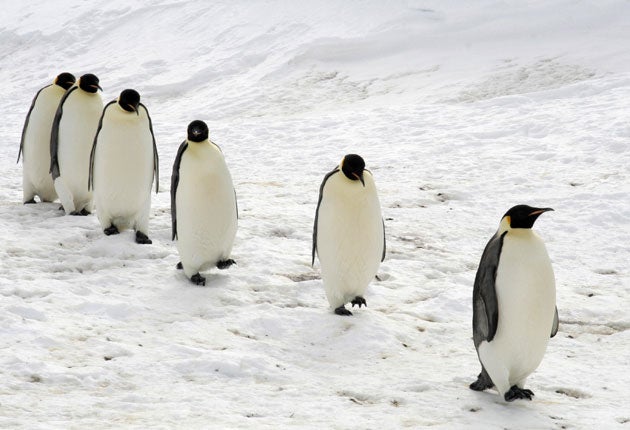By the left, quick march: The Emperor Penguins migration
As Antarctica's sea ice begins to thaw, emperor penguins begin their annual migration to hunt for food. Steve Connor reports

It is that time of year when emperor penguins are on the march. On this occasion, however, the march includes the entire penguin family, including the down-covered chicks about to gain independence from their doting parents. Emperor penguins, which incubate their eggs on sea ice and feed entirely at sea, are probably the only species of bird never to set foot on land. They also have one of the most unusual life-cycles.
As life in the northern hemisphere hunkers down during the shortest days of winter, Antarctica is basking in almost 24-hour sunshine. The sea ice formed last winter is starting to break up and penguin families have begun a long trek to the open sea, where they will feast on fish and squid until the southern winter begins again in March.
There is something endearingly sweet about the emperor's extraordinary life-cycle, which has been honed over thousands of years of evolution by the rigours of the Antarctic seasons and bleak conditions of this most southerly landscape of bitter winds and ice.
If they can, male and female emperor penguins mate for life with courtship beginning after a three-month feeding binge out at sea starting in January. By the end of March, they make the crossing across 60 or 100 miles of sea ice to their frozen rookeries, where the female lays a single egg.
She carefully passes over her valuable egg to her mate, who balances it on his feet before slipping it into the snug warmth of an incubating pouch under his belly. Here he will keep the egg at near body temperature during the worst of the Antarctic winter, when temperature routinely fall to minus 60C and wind speeds reach 100mph.
After laying their eggs, the females immediately return to sea to feed through the winter, while the males huddle together in groups of hundreds or even thousands to keep warm. Those at the edge of the scrum act as a wind-break, providing vital insulation for the rest of the colony, and they are then relieved of their exposed position by those in the middle.
By the time the first eggs begin to hatch in August, the females return to find their mates, who they detect in the crowd by their calls. At this time of year, she can be bigger than him because he has lost up to 40 per cent of body weight by starving over winter. The female emperor penguin relieves her partner of his parental duties, although he somewhat reluctantly hands over the newly-hatched chick before he goes off to sea to feed. In the next few weeks, both parents will take it in turns to feed until the chick is old enough to join others that huddle together in groups to keep warm.
At this point, both parents can feed at the same time, returning to gorge their solitary offspring on a diet rich in marine protein. As a result, the chick piles on weight and grows quickly.
During December, the chicks begin to moult and their woolly grey down is replaced by a more water-proof plumage in readiness for their first journey to the sea. As the sea ice begins to break up, the entire family heads to open water where there is now a rich stock of fish, squid and crustaceans.
It is unusual in the animal kingdom for males to devote so much care to raising their young. Biologists believe the unusual breeding cycle of the emperor penguin, with egg incubation occurring during the coldest time of year, evolved as an adaptation to ensure that chicks enter the sea for the first time to feed when food is most available.
Subscribe to Independent Premium to bookmark this article
Want to bookmark your favourite articles and stories to read or reference later? Start your Independent Premium subscription today.

Join our commenting forum
Join thought-provoking conversations, follow other Independent readers and see their replies